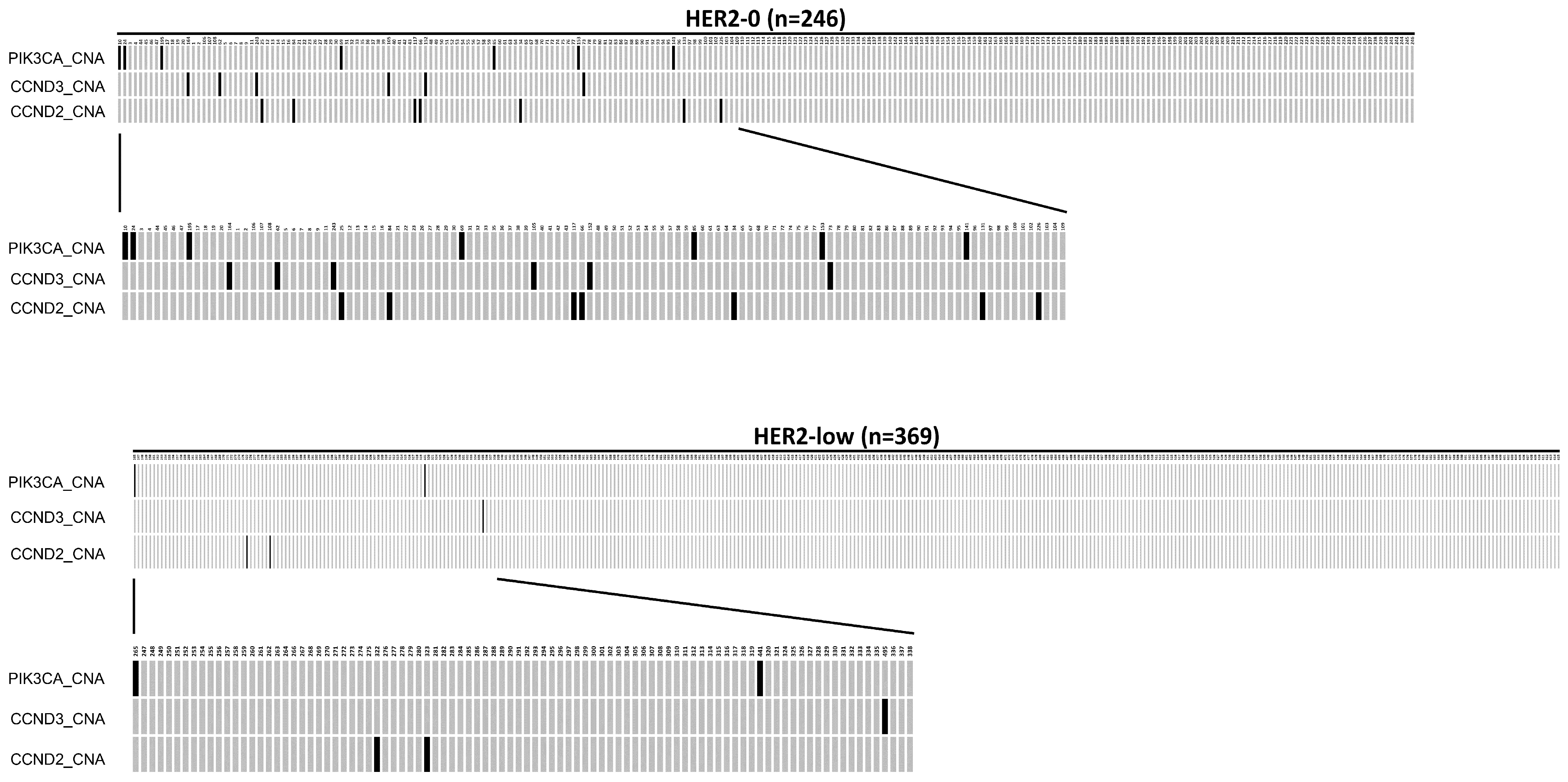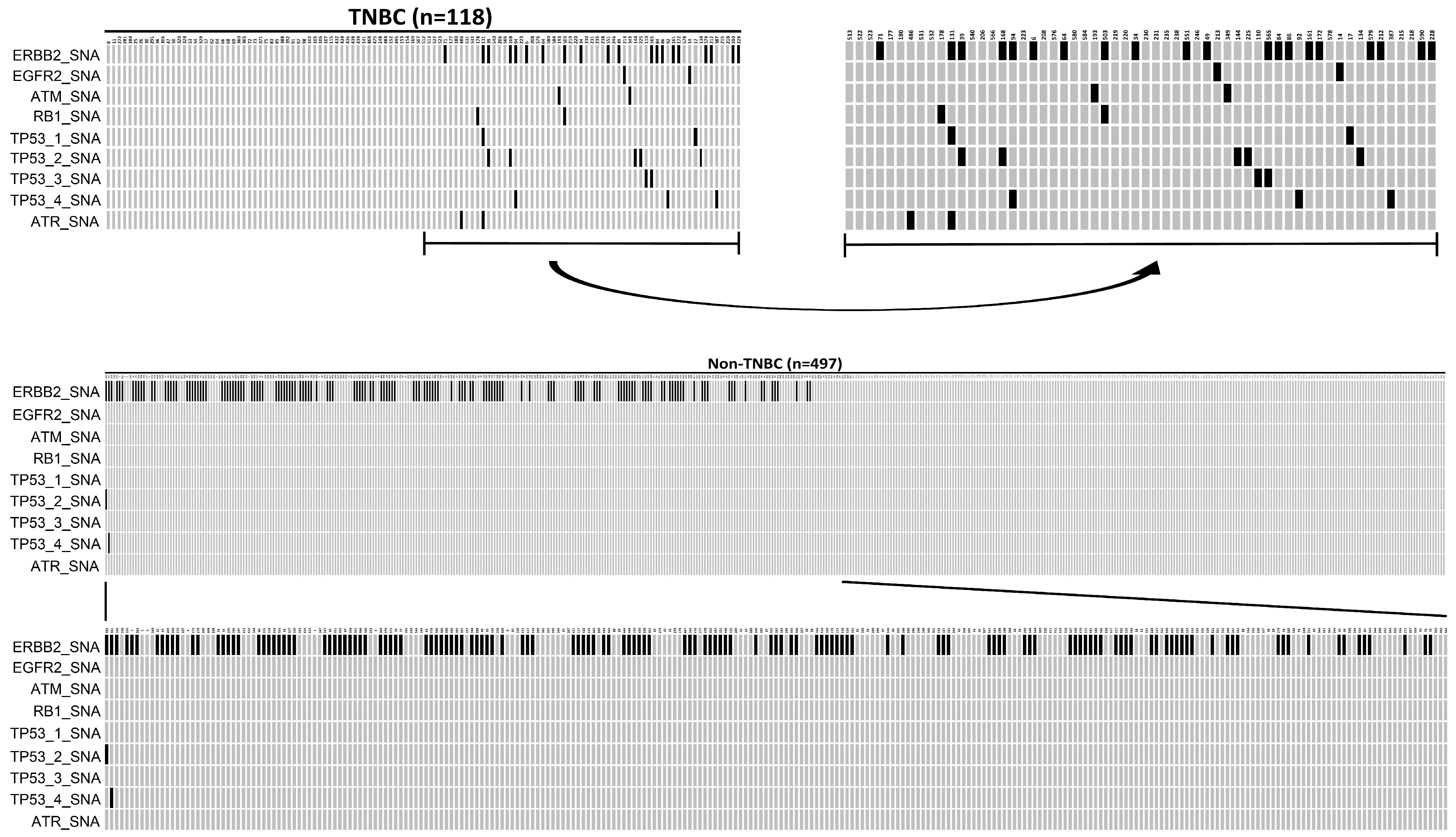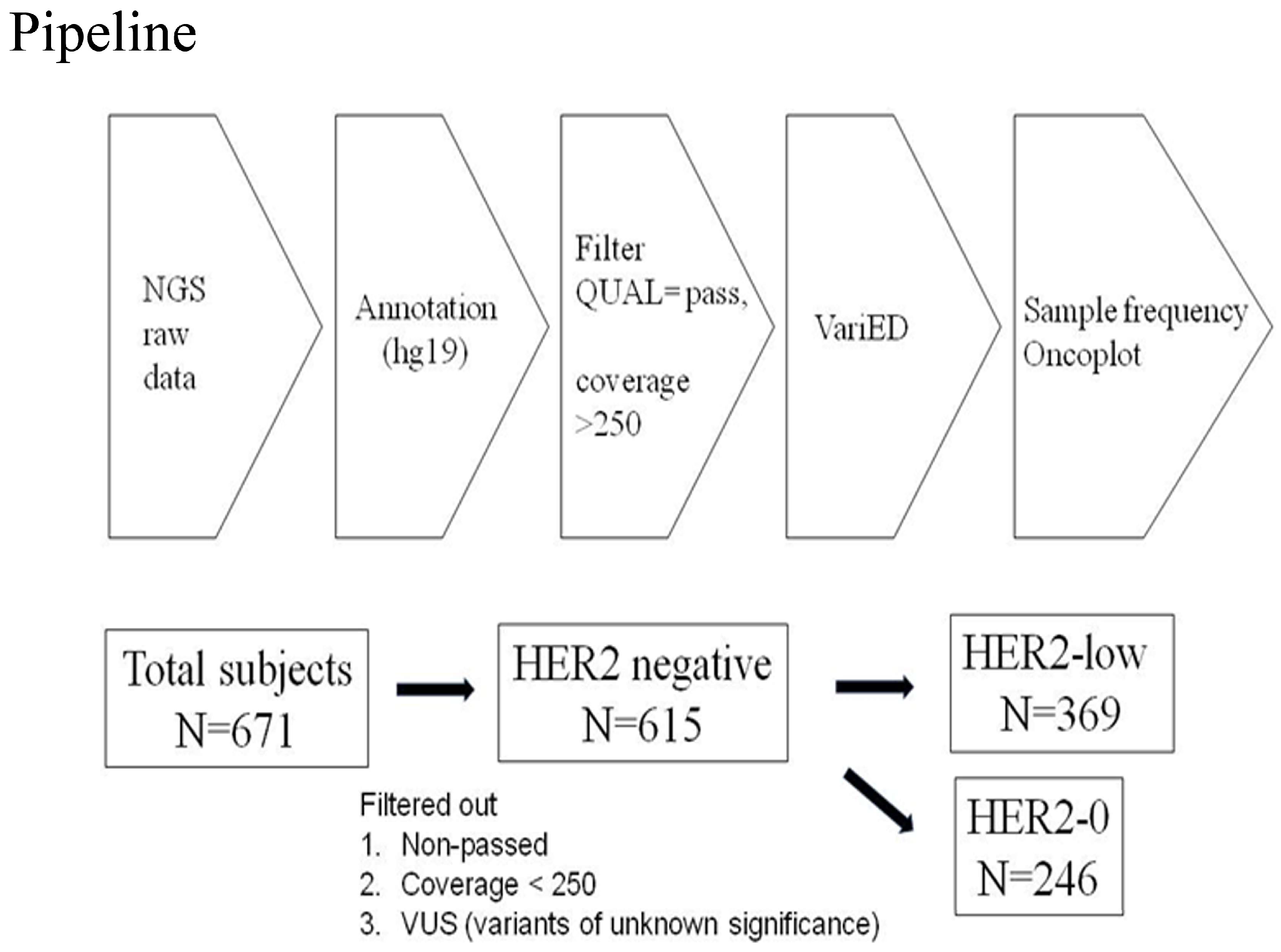Genomic Alterations of Tumors in HER2-Low Breast Cancers
Abstract
1. Introduction
2. Results
2.1. A Comparison of the Clinical and Pathological Features between the HER2-0 and HER2-Low Groups
2.2. A Comparison of Mutation Types between the HER2-0 and HER2-Low Groups
2.3. Actionable Genes between HER2-0 and HER2-Low Groups
2.4. Comparison of Mutational Alterations Present between the HER2-0 and HER2-Low Groups
2.5. Comparison of the Mutational Alterations between TNBC Breast Cancer and Luminal-Like Breast Cancer in HER2-Low Tumors
3. Discussion
4. Materials and Methods
4.1. Study Population
4.2. Pathology Review
4.3. Sample Preparation
4.4. DNA Extraction
4.5. OncomineTM Comprehensive Assay (TMO Comprehensive Assay)
4.6. Statistical Methods
5. Conclusions
Supplementary Materials
Author Contributions
Funding
Institutional Review Board Statement
Informed Consent Statement
Data Availability Statement
Acknowledgments
Conflicts of Interest
Abbreviations
| ADC | antibody–drug conjugate |
| CNA | copy number alteration |
| ER | estrogen receptor |
| HER2 | human epidermal growth factor receptor 2 |
| IHC | immunohistochemistry |
| Indel | insertion/deletion |
| ISH | in situ hybridization |
| NGS | next-generation sequencing |
| pCR | pathological complete response |
| PR | progesterone receptor |
| SA | structure alteration |
| SNA | single nucleotide alteration |
| T-DXd | Trastuzumab deruxtecan |
| VUS | variants of unknown significance |
References
- Tarantino, P.; Curigliano, G.; Tolaney, S.M. Navigating the HER2-Low Paradigm in Breast Oncology: New Standards, Future Horizons. Cancer Discov. 2022, 12, 2026–2030. [Google Scholar] [CrossRef] [PubMed]
- Fehrenbacher, L.; Cecchini, R.S.; Geyer, C.E., Jr.; Rastogi, P.; Costantino, J.P.; Atkins, J.N.; Crown, J.P.; Polikoff, J.; Boileau, J.F.; Provencher, L.; et al. NSABP B-47/NRG Oncology Phase III Randomized Trial Comparing Adjuvant Chemotherapy With or Without Trastuzumab in High-Risk Invasive Breast Cancer Negative for HER2 by FISH and With IHC 1+ or 2. J. Clin. Oncol. Off. J. Am. Soc. Clin. Oncol. 2020, 38, 444–453. [Google Scholar] [CrossRef] [PubMed]
- Wolff, A.C.; Hammond, M.E.; Hicks, D.G.; Dowsett, M.; McShane, L.M.; Allison, K.H.; Allred, D.C.; Bartlett, J.M.; Bilous, M.; Fitzgibbons, P.; et al. Recommendations for human epidermal growth factor receptor 2 testing in breast cancer: American Society of Clinical Oncology/College of American Pathologists clinical practice guideline update. Arch. Pathol. Lab. Med. 2014, 138, 241–256. [Google Scholar] [CrossRef] [PubMed]
- Schettini, F.; Chic, N.; Brasó-Maristany, F.; Paré, L.; Pascual, T.; Conte, B.; Martínez-Sáez, O.; Adamo, B.; Vidal, M.; Barnadas, E.; et al. Clinical, pathological, and PAM50 gene expression features of HER2-low breast cancer. NPJ Breast Cancer 2021, 7, 1. [Google Scholar] [CrossRef] [PubMed]
- Tarantino, P.; Hamilton, E.; Tolaney, S.M.; Cortes, J.; Morganti, S.; Ferraro, E.; Marra, A.; Viale, G.; Trapani, D.; Cardoso, F.; et al. HER2-Low Breast Cancer: Pathological and Clinical Landscape. J. Clin. Oncol. Off. J. Am. Soc. Clin. Oncol. 2020, 38, 1951–1962. [Google Scholar] [CrossRef]
- Modi, S.; Jacot, W.; Yamashita, T.; Sohn, J.; Vidal, M.; Tokunaga, E.; Tsurutani, J.; Ueno, N.T.; Prat, A.; Chae, Y.S.; et al. Trastuzumab Deruxtecan in Previously Treated HER2-Low Advanced Breast Cancer. N. Engl. J. Med. 2022, 387, 9–20. [Google Scholar] [CrossRef]
- Huang, C.-C.; Tsai, Y.-F.; Liu, C.-Y.; Chao, T.-C.; Lien, P.-J.; Lin, Y.-S.; Feng, C.-J.; Chiu, J.-H.; Hsu, C.-Y.; Tseng, L.-M. Comprehensive molecular profiling of Taiwanese breast cancers revealed potential therapeutic targets: Prevalence of actionable mutations among 380 targeted sequencing analyses. Res. Sq. 2020, 21, 1–14. [Google Scholar] [CrossRef]
- Huang, C.C.; Tsai, Y.F.; Liu, C.Y.; Lien, P.J.; Lin, Y.S.; Chao, T.C.; Feng, C.J.; Chen, Y.J.; Lai, J.I.; Phan, N.N.; et al. Prevalence of Tumor Genomic Alterations in Homologous Recombination Repair Genes Among Taiwanese Breast Cancers. Ann. Surg. Oncol. 2022, 29, 3578–3590. [Google Scholar] [CrossRef]
- Tarantino, P.; Jin, Q.; Tayob, N.; Jeselsohn, R.M.; Schnitt, S.J.; Vincuilla, J.; Parker, T.; Tyekucheva, S.; Li, T.; Lin, N.U.; et al. Prognostic and Biologic Significance of ERBB2-Low Expression in Early-Stage Breast Cancer. JAMA Oncol. 2022, 8, 1177–1183. [Google Scholar] [CrossRef]
- Modi, S.; Niikura, N.; Yamashita, T.; Jacot, W.; Sohn, J.; Tokunaga, E.; Vidal, M.J.; Park, Y.H.; Lee, K.S.; Chae, Y.; et al. Trastuzumab deruxtecan (T-DXd) vs treatment of physician’s choice (TPC) in patients (pts) with HER2-low, hormone receptor-positive (HR+) unresectable and/or metastatic breast cancer (mBC): Exploratory biomarker analysis of DESTINY-Breast04. J. Clin. Oncol. 2023, 41 (Suppl. S16), 1020. [Google Scholar] [CrossRef]
- Mosele, F.; Deluche, E.; Lusque, A.; Le Bescond, L.; Filleron, T.; Pradat, Y.; Ducoulombier, A.; Pistilli, B.; Bachelot, T.; Viret, F.; et al. Trastuzumab deruxtecan in metastatic breast cancer with variable HER2 expression: The phase 2 DAISY trial. Nat. Med. 2023, 29, 2110–2120. [Google Scholar] [CrossRef] [PubMed]
- Razandi, M.; Pedram, A.; Park, S.T.; Levin, E.R. Proximal events in signaling by plasma membrane estrogen receptors. J. Biol. Chem. 2003, 278, 2701–2712. [Google Scholar] [CrossRef] [PubMed]
- Shou, J.; Massarweh, S.; Osborne, C.K.; Wakeling, A.E.; Ali, S.; Weiss, H.; Schiff, R. Mechanisms of tamoxifen resistance: Increased estrogen receptor-HER2/neu cross-talk in ER/HER2-positive breast cancer. J. Natl. Cancer Inst. 2004, 96, 926–935. [Google Scholar] [CrossRef] [PubMed]
- Arpino, G.; Wiechmann, L.; Osborne, C.K.; Schiff, R. Crosstalk between the estrogen receptor and the HER tyrosine kinase receptor family: Molecular mechanism and clinical implications for endocrine therapy resistance. Endocr. Rev. 2008, 29, 217–233. [Google Scholar] [CrossRef] [PubMed]
- Giuliano, M.; Hu, H.; Wang, Y.C.; Fu, X.; Nardone, A.; Herrera, S.; Mao, S.; Contreras, A.; Gutierrez, C.; Wang, T.; et al. Upregulation of ER Signaling as an Adaptive Mechanism of Cell Survival in HER2-Positive Breast Tumors Treated with Anti-HER2 Therapy. Clin. Cancer Res. Off. J. Am. Assoc. Cancer Res. 2015, 21, 3995–4003. [Google Scholar] [CrossRef] [PubMed]
- Chen, Z.; Wang, Y.; Warden, C.; Chen, S. Cross-talk between ER and HER2 regulates c-MYC-mediated glutamine metabolism in aromatase inhibitor resistant breast cancer cells. J. Steroid Biochem. Mol. Biol. 2015, 149, 118–127. [Google Scholar] [CrossRef] [PubMed]
- Viganò, L.; Locatelli, A.; Ulisse, A.; Galbardi, B.; Dugo, M.; Tosi, D.; Tacchetti, C.; Daniele, T.; Győrffy, B.; Sica, L.; et al. Modulation of the Estrogen/erbB2 Receptors Cross-talk by CDK4/6 Inhibition Triggers Sustained Senescence in Estrogen Receptor- and ErbB2-positive Breast Cancer. Clin. Cancer Res. Off. J. Am. Assoc. Cancer Res. 2022, 28, 2167–2179. [Google Scholar] [CrossRef] [PubMed]
- Chang, M.T.; Asthana, S.; Gao, S.P.; Lee, B.H.; Chapman, J.S.; Kandoth, C.; Gao, J.; Socci, N.D.; Solit, D.B.; Olshen, A.B.; et al. Identifying recurrent mutations in cancer reveals widespread lineage diversity and mutational specificity. Nat. Biotechnol. 2016, 34, 155–163. [Google Scholar] [CrossRef]
- Samuels, Y.; Wang, Z.; Bardelli, A.; Silliman, N.; Ptak, J.; Szabo, S.; Yan, H.; Gazdar, A.; Powell, S.M.; Riggins, G.J.; et al. High frequency of mutations of the PIK3CA gene in human cancers. Science 2004, 304, 554. [Google Scholar] [CrossRef]
- Samuels, Y.; Waldman, T. Oncogenic mutations of PIK3CA in human cancers. Curr. Top. Microbiol. Immunol. 2010, 347, 21–41. [Google Scholar]
- Martínez-Sáez, O.; Chic, N.; Pascual, T.; Adamo, B.; Vidal, M.; González-Farré, B.; Sanfeliu, E.; Schettini, F.; Conte, B.; Brasó-Maristany, F.; et al. Frequency and spectrum of PIK3CA somatic mutations in breast cancer. Breast Cancer Res. BCR 2020, 22, 45. [Google Scholar] [CrossRef] [PubMed]
- Chao, T.C.; Tsai, Y.F.; Liu, C.Y.; Lien, P.J.; Lin, Y.S.; Feng, C.J.; Chen, Y.J.; Lai, J.I.; Hsu, C.Y.; Lynn, J.J.; et al. Prevalence of PIK3CA mutations in Taiwanese patients with breast cancer: A retrospective next-generation sequencing database analysis. Front. Oncol. 2023, 13, 1192946. [Google Scholar] [CrossRef] [PubMed]
- Pavithran, K.; Jayamohanan, H.; Jose, W.M.; Soman, S.; Vijaykumar, D.K.; Ariyannur, P.S. 256P PI3K mutation is associated with reduced sensitivity to CDK4/6 inhibitors in metastatic breast cancer. Ann. Oncol. 2021, 32, S471. [Google Scholar] [CrossRef]
- Del Re, M.; Crucitta, S.; Lorenzini, G.; De Angelis, C.; Diodati, L.; Cavallero, D.; Bargagna, I.; Cinacchi, P.; Fratini, B.; Salvadori, B.; et al. PI3K mutations detected in liquid biopsy are associated to reduced sensitivity to CDK4/6 inhibitors in metastatic breast cancer patients. Pharmacol. Res. 2021, 163, 105241. [Google Scholar] [CrossRef] [PubMed]
- André, F.; Hurvitz, S.; Fasolo, A.; Tseng, L.M.; Jerusalem, G.; Wilks, S.; O’Regan, R.; Isaacs, C.; Toi, M.; Burris, H.; et al. Molecular Alterations and Everolimus Efficacy in Human Epidermal Growth Factor Receptor 2-Overexpressing Metastatic Breast Cancers: Combined Exploratory Biomarker Analysis From BOLERO-1 and BOLERO-3. J. Clin. Oncol. Off. J. Am. Soc. Clin. Oncol. 2016, 34, 2115–2124. [Google Scholar] [CrossRef] [PubMed]
- Papewalis, J.; Nikitin, A.; Rajewsky, M.F. G to A polymorphism at amino acid codon 655 of the human erbB-2/HER2 gene. Nucleic Acids Res. 1991, 19, 5452. [Google Scholar] [CrossRef] [PubMed]
- Ehsani, A.; Low, J.; Wallace, R.B.; Wu, A.M. Characterization of a New Allele of the Human ERBB2 Gene by Allele-Specific Competition Hybridization. Genomics 1993, 15, 426–429. [Google Scholar] [CrossRef] [PubMed]
- Liu, C.Y.; Huang, C.C.; Tsai, Y.F.; Chao, T.C.; Lien, P.J.; Lin, Y.S.; Feng, C.J.; Chen, J.L.; Chen, Y.J.; Chiu, J.H.; et al. VGH-TAYLOR: Comprehensive precision medicine study protocol on the heterogeneity of Taiwanese breast cancer patients. Future Oncol. 2021, 17, 4057–4069. [Google Scholar] [CrossRef]




| HER2-0 (n = 246) | HER2-Low (n = 369) | p Value * | |
|---|---|---|---|
| Age (years) | 0.742 | ||
| <55 | 120 (48.7%) | 175 (47.4%) | |
| ≥55 | 126 (51.2%) | 194 (52.5%) | |
| Tumor size | 0.878 | ||
| T1 (≤2cm) | 87 (35.3%) | 146 (39.5%) | |
| T2 (2.1–5 cm) | 126(51.2%) | 166 (44.9%) | |
| T3 (>5 cm) | 20 (8.1%) | 24(6.5%) | |
| T4 | 12 (4.8%) | 33(8.9%) | |
| NA | 1 (0.4%) | 0 (0%) | |
| Node | 0.182 | ||
| N0 | 131 (53.2%) | 196 (53.1%) | |
| N1 | 74 (30.1%) | 90 (24.4%) | |
| N2 | 25 (10.2%) | 42 (11.4%) | |
| N3 | 14 (5.7%) | 39 (10.6%) | |
| NA | 2 (0.8%) | 2 (0.5%) | |
| Stage | 0.020 * | ||
| I | 68 (27.7%) | 116 (31.4%) | |
| II | 121 (49.2%) | 137 (37.1%) | |
| III | 35 (14.2%) | 77 (20.9%) | |
| IV | 22 (8.9%) | 39 (10.6%) |
| HER2-0 (n = 246) | HER2-Low (n = 369) | p Value * | |
|---|---|---|---|
| Grade | 0.0001 * | ||
| I | 32 (13.0%) | 64 (17.3%) | |
| II | 119 (48.4%) | 234 (63.4%) | |
| III NA | 86 (35.0%) 9 (3.6%) | 67 (18.2%) 4 (1.1%) | |
| ER | 0.0001 * | ||
| Negative (<1%) | 73 (29.7%) | 46 (12.5%) | |
| Positive (≥1%) | 173 (70.3%) | 323 (87.5%) | |
| PR | 0.0001 * | ||
| Negative (<1%) | 90 (36.6%) | 83 (22.5%) | |
| Positive (≥1%) | 156 (63.4%) | 286 (77.5%) | |
| Ki-67 | 0.0001 * | ||
| <30% | 120 (48.8%) | 249 (67.5%) | |
| ≥30% | 120 (48.8%) | 117 (31.7%) | |
| NA | 6 (2.4%) | 3 (0.8%) |
| Subtype | Mutation Type | Mean | SD | Min | Max |
|---|---|---|---|---|---|
| HER2-0 (246/1124) * | CNA | 1.252 | 1.872 | 0 | 9 |
| (Mean: 4.57 | Fusion | 0.098 | 0.311 | 0 | 2 |
| SD: 5.06 | Frameshift Deletion | 0.207 | 0.463 | 0 | 2 |
| Min: 1 | Frameshift Insertion | 0.378 | 1.738 | 0 | 24 |
| Max: 68) | Missense | 2.110 | 1.414 | 0 | 17 |
| Non-frameshift Deletion | 0.016 | 0.127 | 0 | 1 | |
| Nonsense | 0.508 | 3.287 | 0 | 51 | |
| HER2-low (369/2086) * | CNA | 1.238 | 1.896 | 0 | 11 |
| (Mean: 5.60 | Fusion | 0.122 | 0.344 | 0 | 2 |
| SD: 13.37 | Frameshift Deletion | 0.192 | 0.428 | 0 | 3 |
| Min: 1 | Frameshift Insertion | 1.141 | 10.326 | 0 | 174 |
| Max: 190) | Missense | 2.247 | 1.887 | 0 | 26 |
| Non-frameshift Deletion | 0.024 | 0.154 | 0 | 1 | |
| Nonsense | 0.640 | 5.888 | 0 | 96 |
| Subtype | Gene | Mean | SD | Min | Max |
|---|---|---|---|---|---|
| HER2-0 (246) * | AKT2 | 0.012 | 0.110 | 0 | 1 |
| BRCA1 | 0.049 | 0.358 | 0 | 5 | |
| BRCA2 | 0.098 | 0.412 | 0 | 4 | |
| ERBB2 | 0.280 | 0.459 | 0 | 2 | |
| ERBB3 | 0.004 | 0.064 | 0 | 1 | |
| ESR1 | 0.008 | 0.128 | 0 | 2 | |
| PIK3CA | 0.358 | 0.544 | 0 | 2 | |
| PTEN | 0.008 | 0.128 | 0 | 2 | |
| MDM2 | 0.037 | 0.188 | 0 | 1 | |
| HER2-low (369) * | AKT2 | 0.014 | 0.116 | 0 | 1 |
| BRCA1 | 0.073 | 0.649 | 0 | 9 | |
| BRCA2 | 0.171 | 1.154 | 0 | 14 | |
| ERBB2 | 0.317 | 0.494 | 0 | 3 | |
| ERBB3 | 0.003 | 0.052 | 0 | 1 | |
| ESR1 | 0.008 | 0.090 | 0 | 1 | |
| PIK3CA | 0.493 | 0.595 | 0 | 3 | |
| PTEN | 0.008 | 0.090 | 0 | 1 | |
| MDM2 | 0.038 | 0.191 | 0 | 1 |
| Chrom. | Region | ALT | Type | Gene | Variant ID | Type | Function | Site | Clin Var | HER2-0 (n = 246) | HER2-Low (n = 369) | p-Value |
|---|---|---|---|---|---|---|---|---|---|---|---|---|
| 3 | 178952085 | c.3140A>G | SNA | PIK3CA | COSM775 | missense | gain | exonic | pathogenic | 9.35% * | 17.62% * | 0.006 |
| 3 | 178916549 | AMP | CNA | PIK3CA | amplification | gain | exonic | 2.85% | 0.54% | 0.034 | ||
| 6 | 41903566 | AMP | CNA | CCND3 | amplification | gain | exonic | 2.44% | 0.27% | 0.018 | ||
| 12 | 4383096 | AMP | CNA | CCND2 | amplification | gain | exonic | 2.85% | 0.54% | 0.034 |
| Chrom. | Region | ALT | Type | Gene | AA | Type | Function | ClinVar | TNBC (n = 118) | Luminal-Like (n = 497) | p-Value |
|---|---|---|---|---|---|---|---|---|---|---|---|
| 17 | 37879588 | c.1963A>G | SNA | ERBB2 | p.(I655V) | missense | 16.95% * | 28.17% * | 0.014 | ||
| 10 | 123247516 | c.1975A>G | SNA | FGFR2 | p.(K659E) | missense | Gain | Likely pathogenic | 1.69% | 0% | 0.037 |
| 11 | 108153584 | c.3725delC | SA | ATM | p.(T1242fs) | frameshift Dele | Loss | 1.69% | 0% | 0.037 | |
| 13 | 48953760 | c.1363C>T | SNA | RB1 | p.(R455*) | nonsense | Loss | Pathogenic/Likely pa | 1.69% | 0% | 0.037 |
| 17 | 7576852 | c.993+1G>A | SNA | TP53 | unknown | 1.69% | 0% | 0.037 | |||
| 17 | 7577120 | c.818G>A | SNA | TP53 | p.(R273H) | missense | Loss | Pathogenic/Likely pa | 4.24% | 0.20% | 0.001 |
| 17 | 7577539 | c.742C>T | SNA | TP53 | p.(R248W) | missense | Loss | Pathogenic/Likely pa | 1.69% | 0% | 0.037 |
| 17 | 7578263 | c.586C>T | SNA | TP53 | p.(R196*) | nonsense | Loss | Pathogenic | 2.54% | 0.20% | 0.024 |
| 3 | 142231209 | c.4743_4744del | SA | ATR | p.(F1582fs) | frameshift Dele | Loss | unknown | 1.69% | 0% | 0.037 |
Disclaimer/Publisher’s Note: The statements, opinions and data contained in all publications are solely those of the individual author(s) and contributor(s) and not of MDPI and/or the editor(s). MDPI and/or the editor(s) disclaim responsibility for any injury to people or property resulting from any ideas, methods, instructions or products referred to in the content. |
© 2024 by the authors. Licensee MDPI, Basel, Switzerland. This article is an open access article distributed under the terms and conditions of the Creative Commons Attribution (CC BY) license (https://creativecommons.org/licenses/by/4.0/).
Share and Cite
Tsai, Y.-F.; Huang, C.-C.; Hsu, C.-Y.; Feng, C.-J.; Lin, Y.-S.; Chao, T.-C.; Lai, J.-I.; Lien, P.-J.; Liu, C.-Y.; Chiu, J.-H.; et al. Genomic Alterations of Tumors in HER2-Low Breast Cancers. Int. J. Mol. Sci. 2024, 25, 1318. https://doi.org/10.3390/ijms25021318
Tsai Y-F, Huang C-C, Hsu C-Y, Feng C-J, Lin Y-S, Chao T-C, Lai J-I, Lien P-J, Liu C-Y, Chiu J-H, et al. Genomic Alterations of Tumors in HER2-Low Breast Cancers. International Journal of Molecular Sciences. 2024; 25(2):1318. https://doi.org/10.3390/ijms25021318
Chicago/Turabian StyleTsai, Yi-Fang, Chi-Cheng Huang, Chih-Yi Hsu, Chin-Jung Feng, Yen-Shu Lin, Ta-Chung Chao, Jiun-I Lai, Pei-Ju Lien, Chun-Yu Liu, Jen-Hwey Chiu, and et al. 2024. "Genomic Alterations of Tumors in HER2-Low Breast Cancers" International Journal of Molecular Sciences 25, no. 2: 1318. https://doi.org/10.3390/ijms25021318
APA StyleTsai, Y.-F., Huang, C.-C., Hsu, C.-Y., Feng, C.-J., Lin, Y.-S., Chao, T.-C., Lai, J.-I., Lien, P.-J., Liu, C.-Y., Chiu, J.-H., & Tseng, L.-M. (2024). Genomic Alterations of Tumors in HER2-Low Breast Cancers. International Journal of Molecular Sciences, 25(2), 1318. https://doi.org/10.3390/ijms25021318





